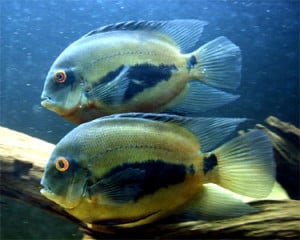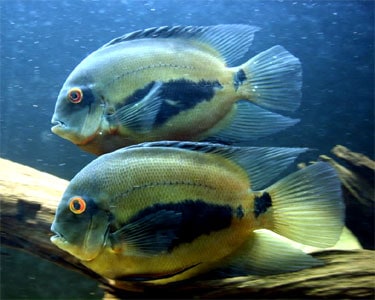
Common Name: Uaru, Chocolate Cichlid, Triangle Cichlid, and Waroo
Scientific Name: Uaru Amphiacanthoides
Average Adult Fish Size: 9.8 inches / 25.0 cm, but occasional specimens have been found to 12 inches / 30.5 cm
Place of Origin: Upper Rio Orinoco; middle and lower Rio Negro basin in the Amazon basin.
Typical Tank Setup: Well planted S. American biotope with rockwork, driftwood / bog wood along with open space. Large Amazon Sword plants are well suited to their environment.
Recommended Minimum Aquarium Capacity: 55 gallon / 220 litre for one, 110 gallon / 440 litre for a pair or more.
Compatibility: Peaceful for a larger S. American Cichlid. Does well in a community tank with fish that are too fast or too large to be eaten.
Temperature: 24-29 Deg C / 75 – 84 Deg F with 27 – 29 Deg C / 81 – 84 Deg F optimal
Water Chemistry: pH 5.5(!) – 7.4
Feeding: In the aquarium it will readily accept all kinds of food and should be kept on a varied diet to ensure optimal health. You can for instance combine prepared foods (flakes, pellets, algae wafers, frozen foods, etcetera) with lettuce, blanched zucchini or spinach and other greens. Also give your fish meaty foods, such as brine shrimp, black worms, mosquito larvae or something similar. Ideally include driftwood in the set up since they like to munch on this as well as any algae that grows on its surface. Unfortunately, the Uaru is fond of eating aquarium plants and is known to eat them down to the roots. Some aquarists report that feeding Uaru a lot of leafy greens will make it less interested in destroying aquarium plants.
Sexing: It is very hard to sex Uaru cichlids based on external characteristics. At full size the males have somewhat more pointy genital papillae than the female and they are also known to grow a bit bigger. If you wish to breed this species, the easiest method is normally to raise a group of 6-8 young fish together and let them do their own pairing. Venting is the only sure way to determine gender of juvenile Uaru.
Breeding: The female will deposit her eggs on a flat surface, such as a flat stone, a piece of slate or a flowerpot. One batch normally contains 100-400 eggs and the offspring are guarded by both parents. The fry hatch within 2-4 days and are then moved by their parents to a spawning pit dug out in the gravel. They stay in the pit until they become free swimming 3-4 days later.
You don’t have to feed really young Uaru fry because the parents will excrete slime from the sides of the body for the offspring to eat similar to Discus. When the fry are about two weeks old you can start giving them finely powdered flake food and newly hatched brine shrimp.
When given a proper diet and kept in suitable conditions, Uaru fry grow remarkably fast. The fry are dark before developing a yellow/golden colour with white speckles. When they reach a length of roughly two inches (5 cm) they loose this speckled appearance.
Don’t loose heart if your Uaru couple eat eggs and/or fry during the first initial spawning. It is common among young parents and they will most likely get it right if you allow them to continue breeding. Leaving the lights on during the night might decrease the risk of them accidently eating their own offspring.
If they continue to fail, you can remove the fertilized eggs to a separate container but since there will be no parents to fan fresh water over them you must keep the water well aerated and add some type of anti-fungal remedy, e.g. methylene blue. It is possible for Uaru fry to survive without getting any slime from their parents.
Additional Information: While not the prettiest of the larger cichlids, Uaru’s make up for it with personality. This writer has known some Uarus to become extremely attached to their owner to the point where they like to be petted and their head scratched! In large aquariums they are often kept with Discus. They are a very social and schooling fish in the wild and do best when kept in small schools of 3 or more. A solitary fish may sulk and become depressed if it doesn’t find a tank mate to its liking. They require excellent filtration and frequent water changes. The water quality and temperature for them is similar to Discus.


Related Posts
Croaking Gourami – Trichopsis vittatus
Benthochromis Tricoti
Large-eyed Mouthbrooder – Callochromis Macrops